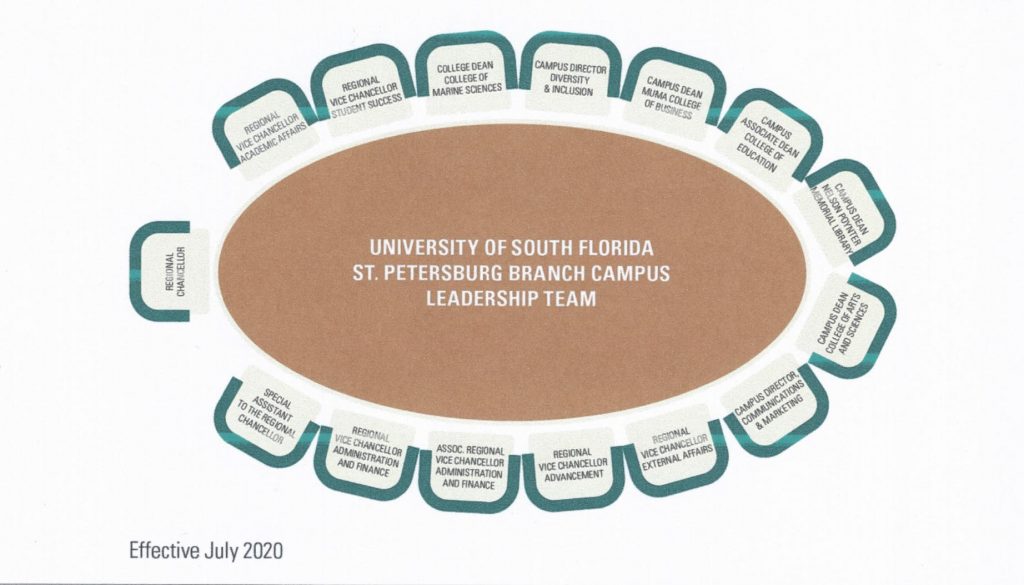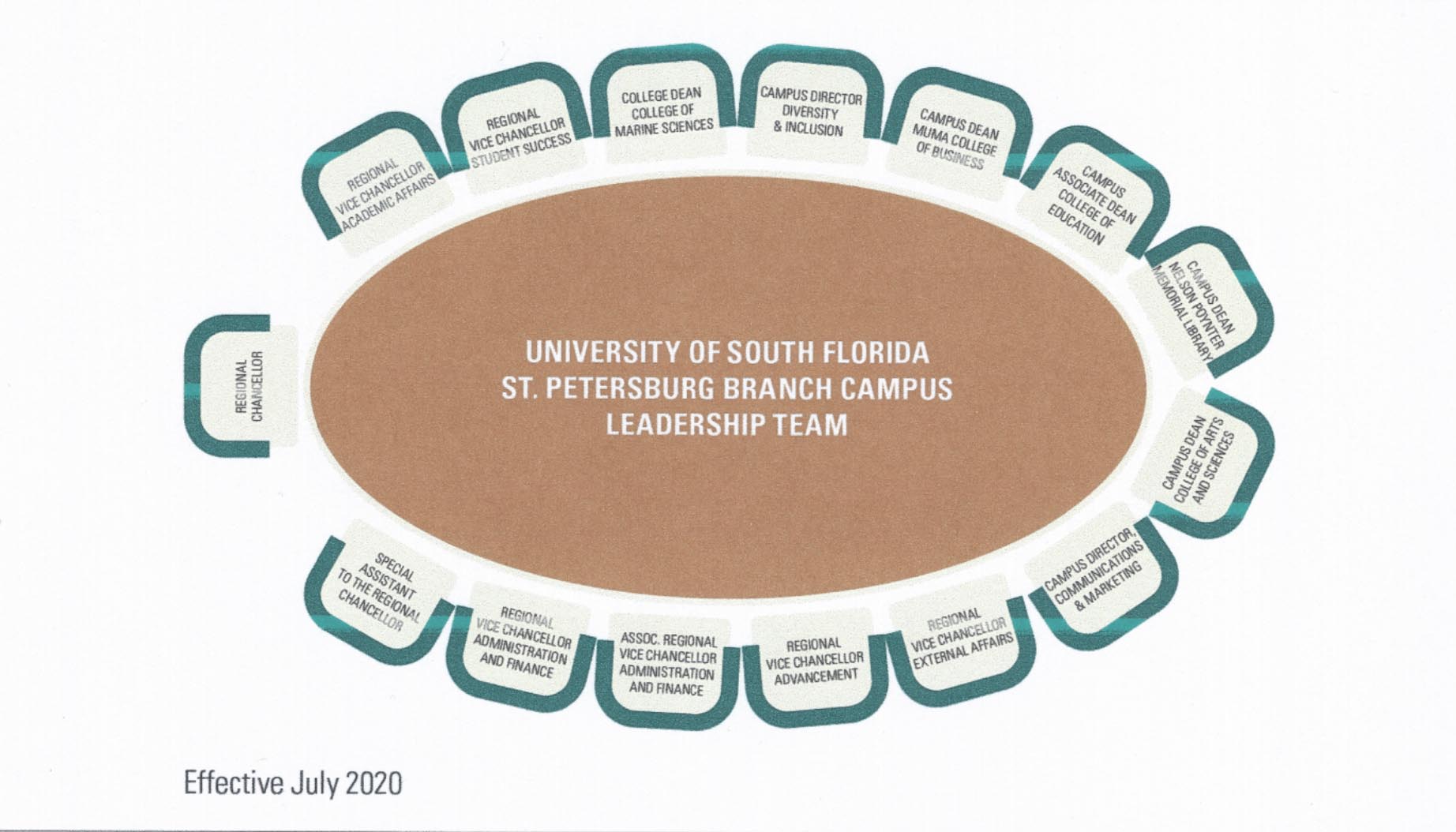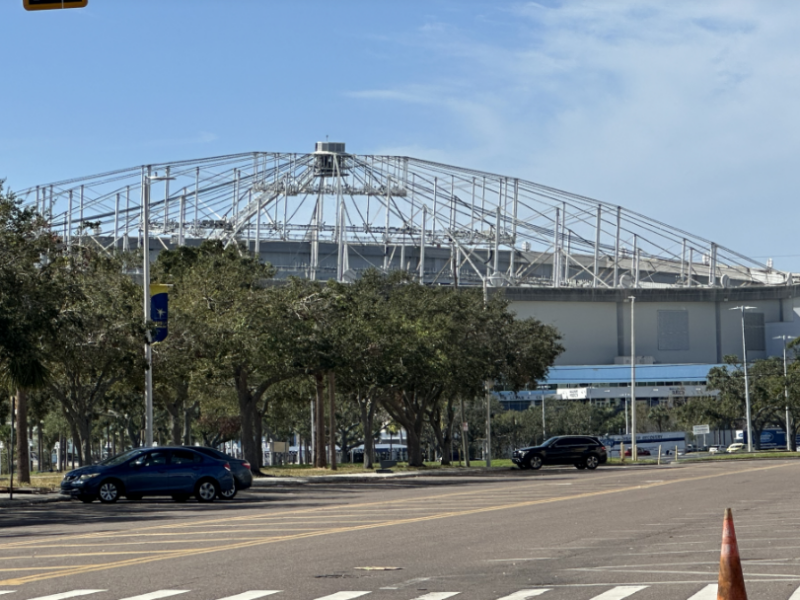
Courtesy of USF Consolidation Academic and Student Success Implementation Handbook
By Nancy McCann
The USF administration in Tampa, which has zigzagged through months of consolidation planning, has done another about-face.
Revised organizational charts and new details released late Friday appear to square with state law requiring St. Petersburg and Sarasota-Manatee to operate as full branch campuses once consolidation takes effect July 1.
They show five regional vice chancellors in St. Petersburg reporting to Regional Chancellor Martin Tadlock.
Only three weeks ago, the organizational structure proposed by USF system President Steve Currall had no leadership positions on the St. Petersburg campus reporting directly to Tadlock.
All of the solid reporting lines in the charts went to Tampa.
Shortly after the revisions were released to university leaders at 4:12 p.m. Friday, The Crow’s Nest emailed university system spokesman Adam Freeman seeking Currall’s comments on the changes and asking why his administration has changed position twice in recent weeks.
Freeman said Currall was unavailable to respond, and provided a response from USF system Provost Ralph Wilcox.
Regarding the abrupt turnaround last week, Wilcox answered that as consolidation documents are finalized “it is important to ensure accuracy, clarity and consistency of guiding documents and practice as USF prepares to operate as one, singly accredited university beginning July 1, 2020, consistent with state law.” (See Wilcox’s full statement below.)
Tadlock welcomed the changes, noting that the “revised organizational charts and accompanying text better reflect the definition of a branch campus than what was contained in the first version” of charts last month.
He reminded the St. Petersburg campus that “consolidation is a work in progress and will unfold over a long period of time. There will be starts and stops and pauses and leaps forward.” (See Tadlock’s full statement below.)
One of the regional vice chancellors who would report to Tadlock under the latest organizational revision is Patricia Helton, the campus’ chief administrator for student affairs and student success.
Asked for her reaction, she said, “This is a good change for USFSP. The changes restore local authority to the Chancellor thereby shifting back the hiring and firing authority.”
In the prior version of the organizational charts, Helton was shown reporting directly to Paul Dosal, vice president for student success in Tampa.
History professor Ray Arsenault, who last month blistered the Currall administration for “backsliding” and causing “needless confusion and heartache,” is speaking at a conference in Paris and could not be reached for comment.
The changes released Friday mark yet another turnabout for the administration of Currall, who inherited the hot potato of consolidation when he succeeded longtime USF system President Judy Genshaft last summer.
For months, Genshaft made clear that her top priority in consolidation was maintaining the Tampa’s campus newly won designation as a state preeminent research university – status that she feared the St. Petersburg and Sarasota-Manatee campuses might jeopardize.
She suggested that the two smaller campuses could be “somewhere in-between” a branch campus and a less prestigious instructional site.
But many in St. Petersburg took a dim view of her position, and so did the Pinellas County legislators who – in a surprise move in 2018 – abolished the independent accreditation of St. Petersburg and Sarasota-Manatee and rolled the three campuses into one.
In 2019, they rewrote state law to insure that St. Petersburg and Sarasota-Manatee would be full branch campuses with their own budgetary and hiring authority and their own faculty and administrative organization.
When he took over last July, Currall assured St. Petersburg and its allies in government and the Pinellas business community that the campus would not lose its autonomy or distinct identity.
But a “preliminary blueprint” he released a few weeks later took control of academic and student affairs away from Tadlock and moved those responsibilities to Tampa.
That prompted a firestorm in St. Petersburg and stern words from Pinellas legislators, and in October the Currall administration issued a revised plan that gave Tadlock “clear responsibility” and authority for the campus.
When the administration presented a handbook on consolidation on Jan. 9, however, the organizational charts it contained once again stripped away much of Tadlock’s authority.
Those charts did not match the description of a branch campus offered last year by Belle Wheelan, the president of the accrediting agency that oversees colleges and universities in the Southeast.
A branch campus, she told The Crow’s Nest, is a “full-blown operation with someone in charge.”
Under the plan released Friday, the five regional vice chancellors reporting directly to Tadlock are Catherine Cardwell (academic affairs and vice provost); Helen Levine (government and external relations); Nick Setteducato (administration and finance); Deborah Read (advancement); and Helton (student success and student affairs).
The plan also illustrates various leadership groups on the three campuses, including St. Petersburg’s branch campus leadership team. (See diagram.)
St. Petersburg’s campus and associate deans are still shown as reporting directly to college deans in Tampa.
Tadlock said there will be a St. Petersburg campus forum at 11 a.m. on Feb. 5 in Davis 130 “to update everyone on the proposed organizational structure of the consolidated USF.”
Provost: Ensure accuracy, clarity

The Crow’s Nest asked USF system President Steve Currall to respond to questions about last week’s consolidation revisions. Provost Ralph Wilcox provided answers in an email.
What are the most important changes in the revised consolidation handbook and organizational charts released on Friday? How do the changes bring the St. Petersburg and Sarasota-Manatee campuses back on track as full branch campuses?
“The recent additions and revisions to the USF Consolidation Academic and Student Success Implementation Handbook include the first USF Branch Campus Organizational Chart specifying membership of the regional chancellor’s Branch Campus Cabinet and accompanying revisions to membership roles, relationships and responsibilities.
“Also added to the document are new representations of university-wide and branch campus leadership groups. These plans confirm the regional chancellors’ membership on the USF President’s Cabinet, inclusion of the regional vice chancellor for academic affairs on the USF Council of Deans along with broadly representative, though distinctive, Branch Campus Leadership Teams led by each regional chancellor.
“Consolidation planning and implementation seek an optimal balance between the letter and intent of state law, the expectations of regional and specialized accrediting agencies, and the USF Board of Trustees’ Guiding Principles for Consolidation.”
Why was there a reversal from the October vision of organizational structure for St. Pete and Sarasota – which seemed to hit close to the mark for branch campuses – and then another quick turnaround this week?
“As USF works to finalize the Substantive Change Prospectus, and support documentation, for submission to SACSCOC (the accrediting agency), it is important to ensure accuracy, clarity and consistency of guiding documents and practice as USF prepares to operate as one, singly accredited university beginning July 1, 2020, consistent with state law.”
Chancellor: Focus on student success

The Crow’s Nest asked Regional Chancellor Martin Tadlock for his reaction to the updated organizational charts for consolidation. This was his response:
“I believe the revised organizational charts and accompanying text better reflect the definition of a branch campus than what was contained in the first version of consolidation volume one. I appreciate the president’s leadership throughout this very fluid process, and the patience and support of so many members of the university community, and our extended communities, as we work through this.
“As I continually remind people, consolidation is a work in progress and will unfold over a long period of time. There will be starts and stops and pauses and leaps forward. What matters most is that we stay focused on the success of our students as we work through this complex process.
“Our incredible faculty and staff have managed to do that extremely well despite the distractions, and our success metrics are evidence of that. I am very fortunate to be surrounded by phenomenal people, and in the end that is what will make consolidation work.”




Because what USF really needs is a dozen or so more administrators making multi $100,000 salaries. That way, they won’t have to waste money on students and faculty, who get in the way of administering the university anyway.